I.
Cafe On/Off in Yongsan-dong has sticky beige tile, with swaths of 8 by 8 brown blocks. The interior is more Buffalo than Seoul, the kind of modest establishment that might serve your coffee in a styrofoam cup, which is an anomaly in a city where you typically can’t walk into a cafe without having to shimmy under an artificial waterfall that smells like a Tom Ford scented candle just to order an iced americano.
This morning at On/Off, a sixteen year old corgi named Kott-yi is throwing up, its foamy yellow blending in with the tile, and I am concerned the cafe’s owner might blame me after I fed the dog a piece of my apple fritter.
Sometimes Kott-yi will rest his head on my foot, and I can feel his heavy snores rattling from his throat against my toes. It’s the closest I get to human or animal contact, and, although it hurts each time Kott-yi inevitably stands up and greets someone else dropping fritter crumbs, I appreciate this old dog ritual in my new and surprisingly cozy neighborhood.
These small moments, a dog's warmth against my foot, speaking in English with a barista, a Korean grandmother hanging on my shoulders during a crowded bus ride, have become my measure of a satisfying day, tiny acknowledgments of my existence in a place where I am otherwise invisible. It seems I am settling into a comfortable and quiet obscurity.
These last few weeks in Seoul conjure a wistfulness that takes me back to San Antonio, where I often visited the Wonderland of the Americas mall to see a movie at the Santikos Bijou, the only theater in the city that reserved one of its six screens for indie films in the mid-2010s. The Burlington Coat Factory towered over a corridor of immaculate 1990s aesthetics: interior iron tree gates inset in the mall’s brown tile floor beneath enormous terracotta planters, glass elevators, and coin-operated kiddie rides. Although there were only a few dozen visitors each day, the fountains still ran, their chlorinated water looping endlessly.
On a typical visit, I might pass a woman at a folding table in the mall’s main corridor selling homemade gel candles with beach shells suspended inside, or a defunct LIDS now repurposed as a shop specializing in infant-sized anime figurines.
Even on a Friday night, the mall’s movie theater, the Santikos Bijou, always carried the air of a Tuesday matinee. In the shadow of Alamo Drafthouse, it did its best, opening the Bijou Bistro with a selection of Yellowtail, live music from a keyboardist who took requests via golf pencil and receipt paper, and a small dining area that always remained empty.
Here, the rumbling of superhero movies felt embarrassed, nudging the walls with a bored routine during climactic showdowns. The Bijou regulars were not Marvel Universe enthusiasts. No, these patrons drove 35 minutes to watch Michael Fassbender play a brooding widower who takes a vow of silence while restoring a crumbling lighthouse or a documentary about Somali refugees working in a Wisconsin meatpacking plant.
One of the full-time employees at the Bijou was an old man, maybe in his mid-70s, who ripped tickets while hunched over a pedestal in his pressed dress shirt and red bow tie.
He never made eye contact, carefully collecting each ticket into his breast pocket, then counting the stubs into a neat pile on the glass concession case before recording the total in a tiny notebook with a #2 pencil. It was impossible to tell whether he worked at the Bijou out of necessity or pleasure, though I suspected it was a bit of both. Maybe his social security check wasn’t enough, or his doctor recommended he stay active, or maybe, simply, he just loved the movies.
Sometimes, I’d find him in the main corridor, waiting for a movie to let out, broom and pan in hand, his gaze drifting over the paintings in the Bijou’s rotating art gallery, as if he just stumbled upon them. He would look transfixed, the way children stare at a stranger’s deformity at a bus stop, recalculating everything they’ve learned about hands, feet, faces, to make room for this new and interesting information.
The official Santikos Bijou Gallery often featured paintings by amateurs. Wolverines were sketched in faded yellow pencil on tracing paper. Acrylic renderings of the yellow brick road, speckled with glitter from a Gelly Roll. A portrait of Selena, assembled from heated plastic beads. With every piece, the artist’s name and age were inkjet-printed, mounted on foam core, and placed with careful finesse.
There was so much care poured into the gallery, I almost feel teary-eyed recalling it. Walking down the hall during my visits, I could practically hear Louis Vasquez, 73, proudly telling her daughter, “My water color portraits of Oprah Winfrey are hanging at the Santikos!” I could see the parents taking their kids to The Lego Movie and then admiring the oldest son’s pastel rendering of their pet basset hound. “It looks just like him, Danny!” The dad might say, putting his arm across his son’s shoulder, his fingers still sticky with butter.
Once, my sister-in-law, Lisa, bought one of these paintings, two white ducks swimming in a San Antonio reservoir . I imagine how excited the artist felt hearing the news that the ducks sold, perhaps calling their family, telling their co-workers in the break room, proud that someone cared enough to stop, look, and take home something they made to hang forever on a bathroom wall.
II.
Before moving to Seoul last month, I spent two years in Ansan, a small city about an hour outside the capital. Ansan’s neighborhoods, Gojan, Banwol, and Woolpi-dong, are stitched together by wide highways, all leading in and out of the manufacturing zone and toward Oido Port. Most of the buildings stand in clusters of identical grey configurations, linked by a grid of empty sidewalks with a few franchise chicken shops and real estate offices.
The school, a thirty-minute walk from the train, is nestled against Gwangdeog Mountain, and I lived in a faculty apartment at the very top of the campus’ rear-most building, giving me a mythic Hunchback of Notre Dame-esque reputation—my shadowy, big-nosed figure appearing at 2 a.m., refilling an old plastic water bottle or stumbling up the steps after a night out, as students pulled all-nighters rehearsing for the semester’s musical.
Hearing a grown man mumbling in a foreign tongue and fumbling around the stairwell at odd hours didn’t sit well with the students, who already gossiped about Ansan’s sordid history, a city that housed two of South Korea’s most infamous serial killers and bore the weight of the Sewol Ferry Disaster, which claimed the lives of 250 high school students. Most who live and work there would agree: the city is, without question, cursed.
So moving to Seoul, with its winding back alleys, unusual bars, art museums, and the characters that make up city life, has provided unexpected moments of quiet recognition, whether from a passing dog or an old grandmother. After two years in Ansan, I’ve finally been granted the bare minimum of inspiration to make life feel bearable again.
Just last week, my landlord left me baked sweet potatoes and about a dozen soft boiled eggs in a brown paper bag.
While looking to furnish my apartment, a used furniture salesman, who didn’t speak any English and had no idea how to use a smartphone, rode alongside me with my new used stool, end table, and shelf strapped to the back of his scooter as I made the twenty five minute walk back to my apartment.
There is a bakery and park nearby where I pick up baked goods and hang out to watch families take photos of their newborns on the playground.
These moments bring me just enough joy and I feel right at home taking on this awkward role of man on a park bench eating banana bread and laughing at toddlers going down the slide backwards.
Part of these moments of contentment in Seoul might be the opportunity to live in a first world megacity while simultaneously being broke by all USD standards. Sitting on my squatty potty in my half toilet/half shower, I tell myself with a sense of gratitude, this is hot water, this is an apartment, this the city, and this is a full bottle of Dr. Bronners. It’s not such a bad life.
My friend Jenna was in Seoul last year, and when I asked if I should leave, she said, without a beat, “Yes. You’re too old not to be building a home in the place where you actually want to live.”
She’s right. Seoul is not my home, and it’s not a place where I want to build a career or family. But, there’s a sweet horror in acknowledging that your desires for this life may never even get close to a reality, that you can be a failure, and still stand in your half shower half toilet and feel that things aren’t so bad.
I think about this uneasy sense of gratitude each time I treat myself to Baskin Robbins on a Friday night, a large single scoop in a waffle cone, and walk back to my apartment from a a movie at the CGV. An (almost) middle-aged man, alone, licking an ice cream cone.
The image stirs up a strange yearning, the same pang I get watching someone eat alone at a Wendy's. A shop owner meticulously organizing his display case of Gameboy Color cartridges in an empty store. An elderly movie theater usher quietly marking down how many tickets were sold for the matinee screening of The Grand Budapest Hotel, his handwriting uneven from his unsteady hands.
Last night, I walked home from the Han River, finishing the last bite of my waffle cone, and opened my front door to my TV tray, twin bed, and air fryer. Everything I need, in a single room, greeting me with a cozy surrender.
Seoul isn’t the right place for me, I am certain. But, despite that, what I have found here is this peculiar freedom to disappear. To become so invisible, you’re not just hiding from the world, but your own expectations for it.
Tomorrow, I will put on a white shirt and wrap a red bow tie around my collar. I will walk outside and take the 77 bus to the Santikos Bijou.
The teenager behind the ticket booth will give me a glance, curious about the new hire. At first, the other employees will be suspicious. But I will follow the old man's steps so precisely that they'll stop asking questions and eventually forget about him.
I will take my lunch in the food court, where I will hear the sounds of a child laughing, rocking on the coin-operated kiddie ride, plasticine Bozo the Clown in the passenger seat. On my birthday, I will get a table for one at Maggiano's and order the baked ziti and a cannoli. Years will pass. I will think about how quickly the time went. I will think about how thankful I am for the old man. How he gave me everything I needed to make a life: his small apartment, an electric kettle, a television set, and a bus pass.
On my day off next week, I will visit the bi-monthly antique toy fair at the YMCA. Maybe I will walk to the new Chinese buffet a few blocks away.
I will make sure my uniform is ironed, I will do my laundry, and I will watch Robert Altman movies at night (after all, I will get to see the new movies for free). But I won't go to bed too late. Tomorrow, I will take the bus back to Santikos, and prepare the labels for the new exhibition in the gallery.
It’s a sweet fantasy. And here, alone on the streets of Seoul, thousands of miles from the Bijou, I feel like I’m right on the precipice of making it real.
Oh, sweet, Bijou,
Let me rip those tickets for you,
Ride the #33 home with leftover popcorn
in a Target bag.
Oh sweet Bijou, It’s not such a bad time, this life.
It’s not so bad at all.
The Santikos Bijou closed in April, 2022.

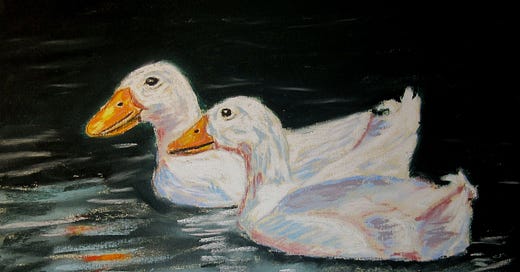



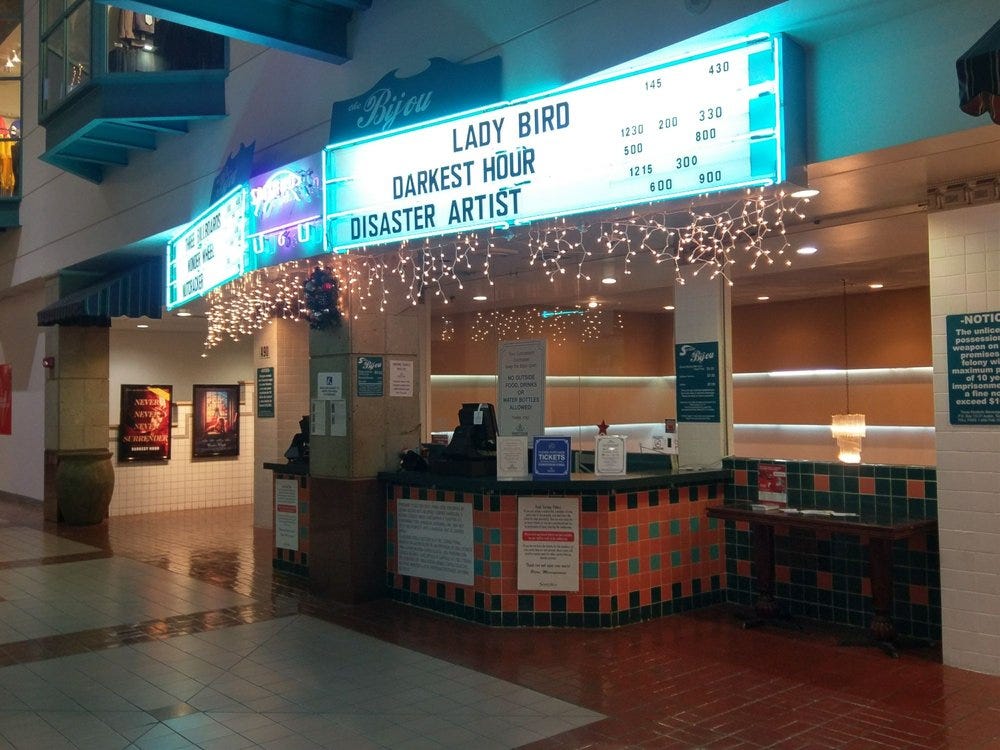
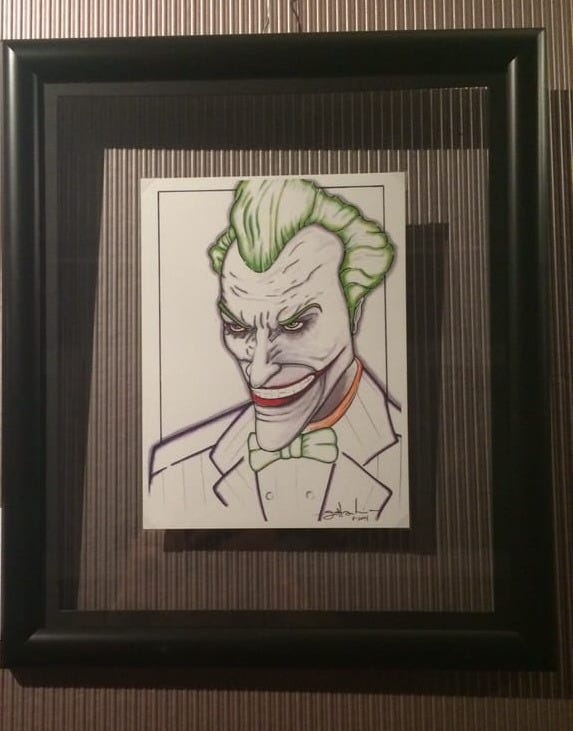

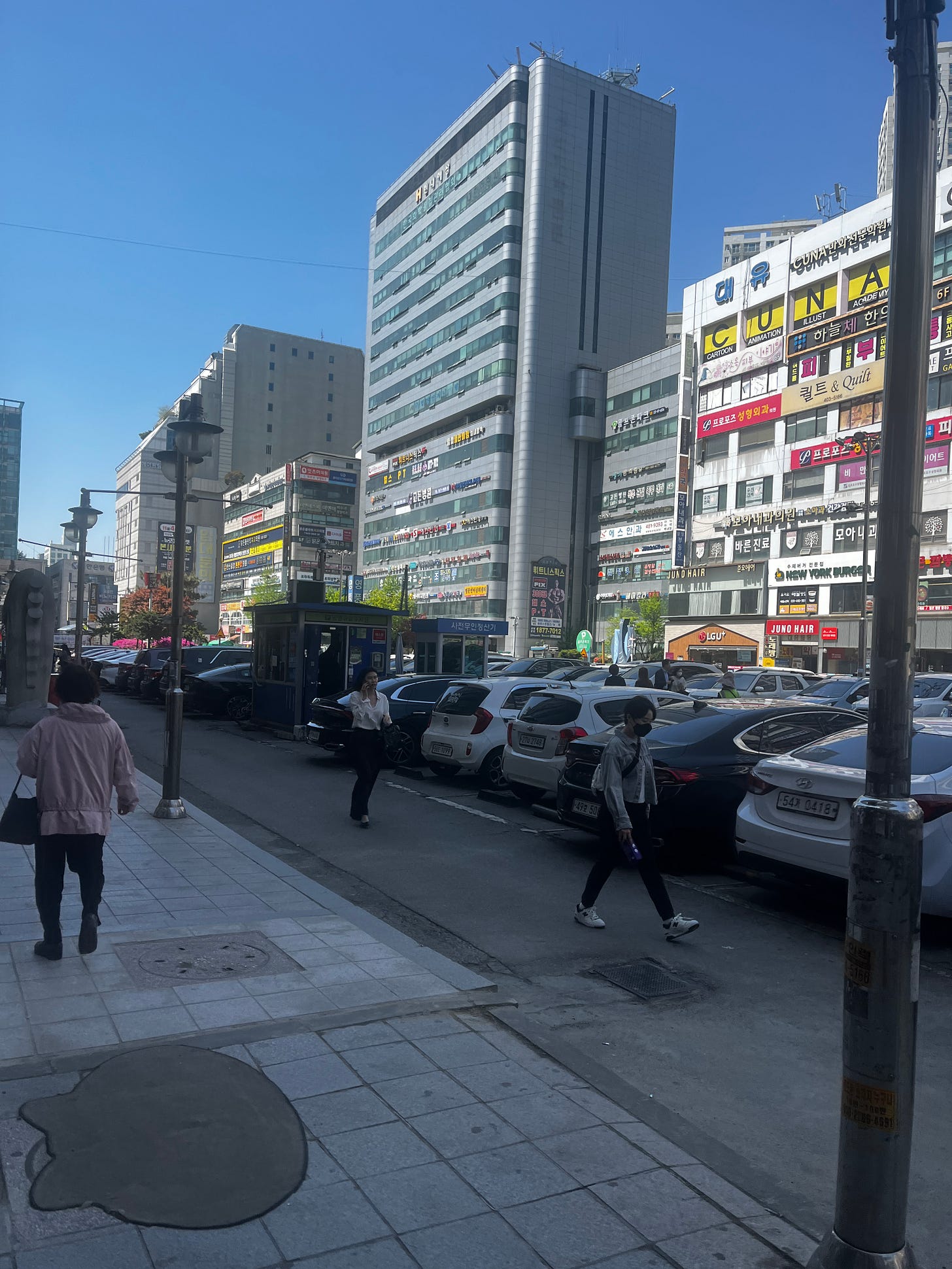
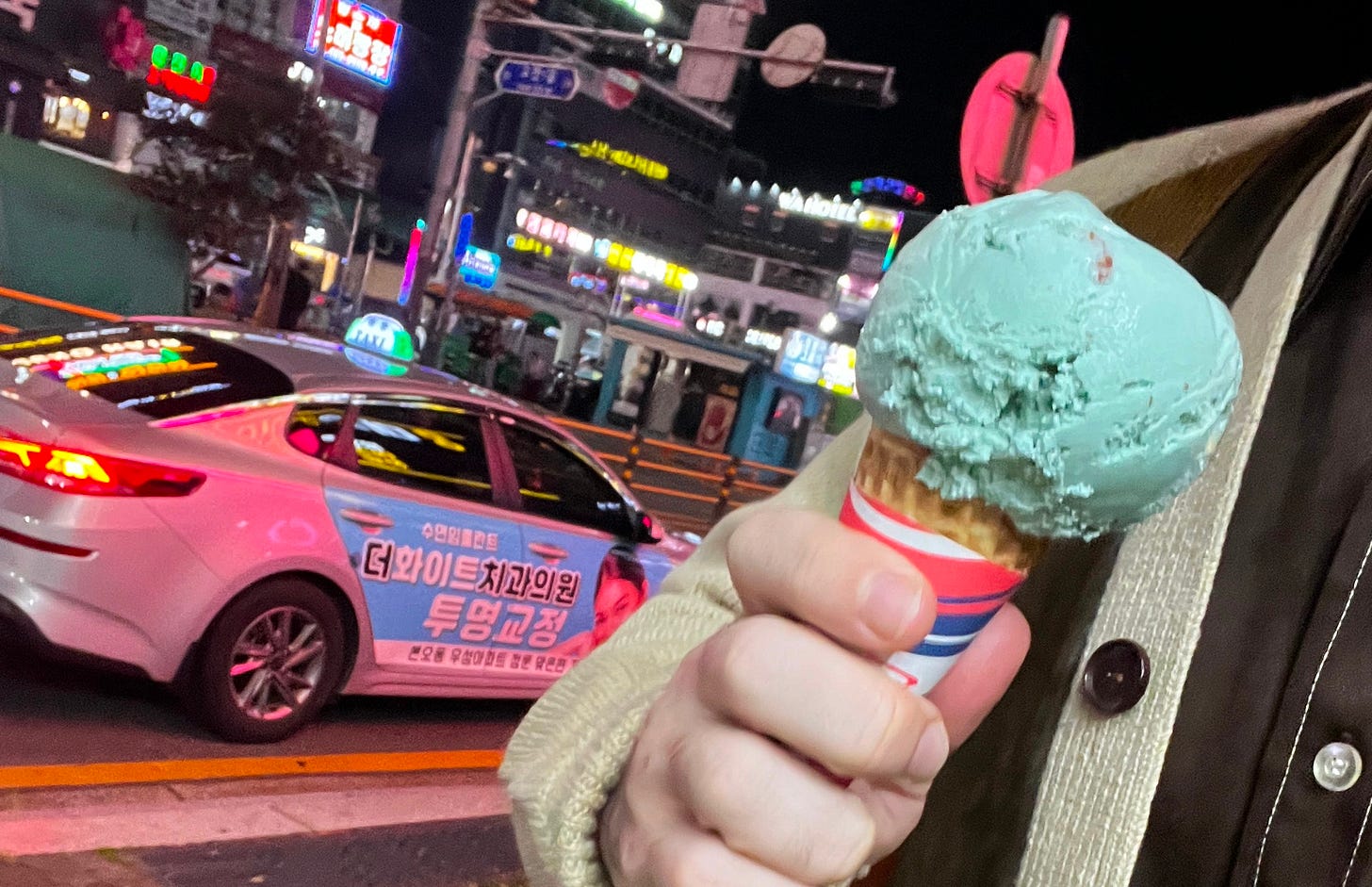

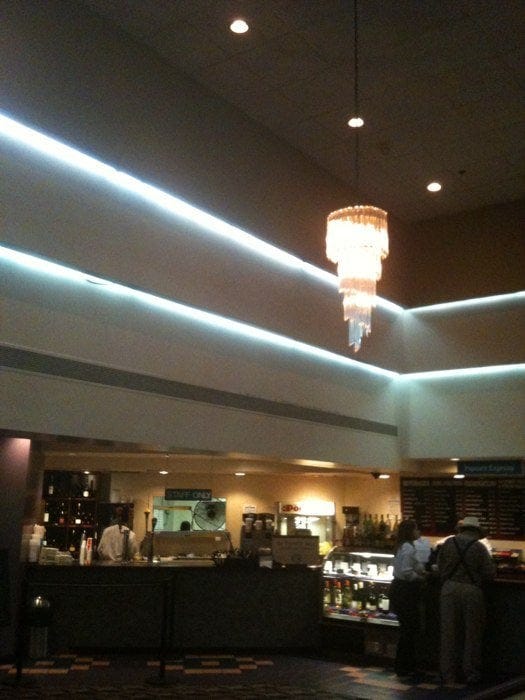
🪿🪿
wow i can’t wait to visit that cursed village and maybe even try out that squatty potty for myself.
is that spumoni or chocolate chip mint?
🎟️
😓